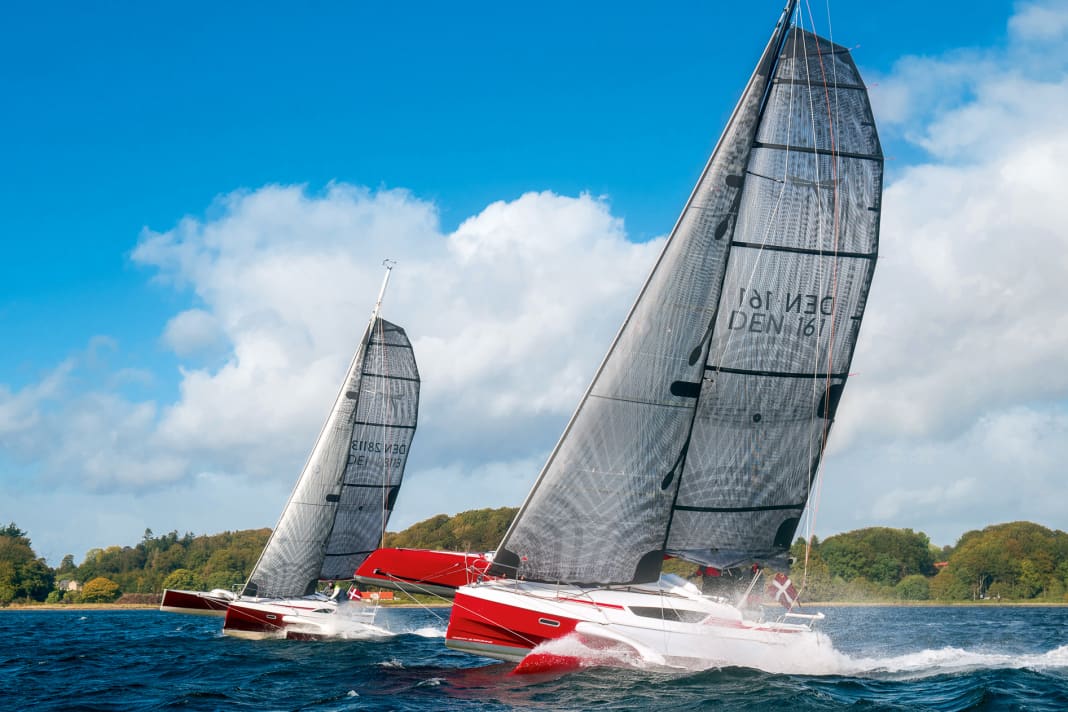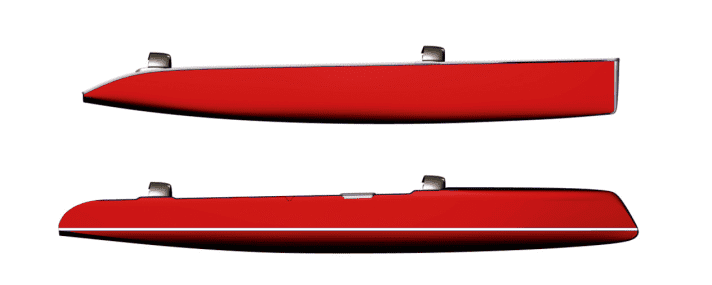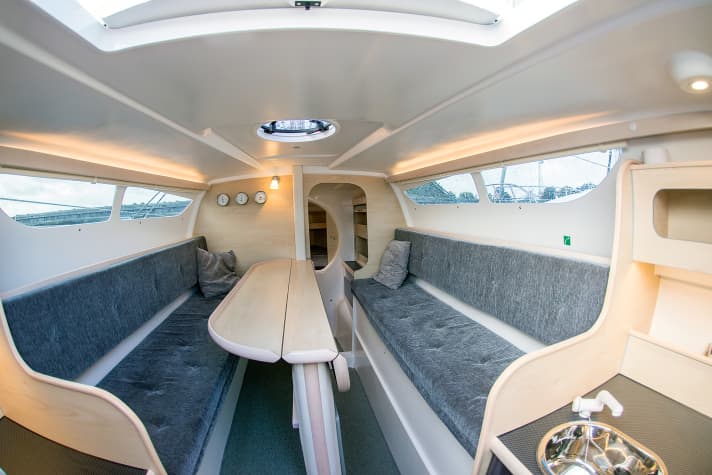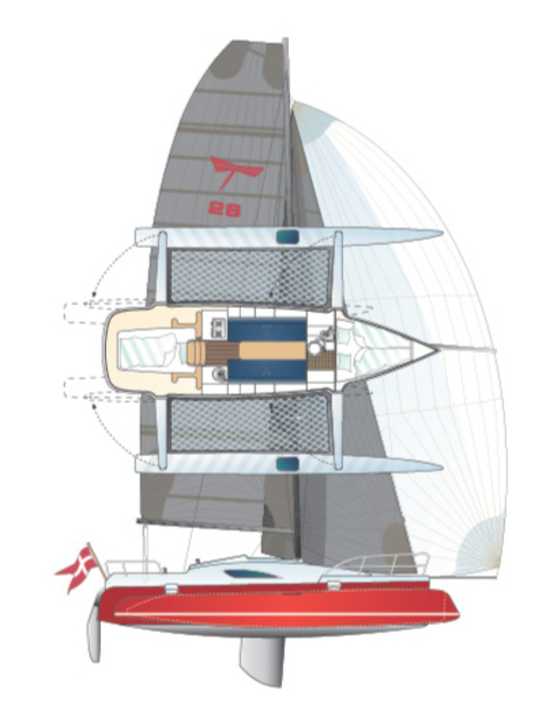





Do you know Tim Taylor, the do-it-yourself king? In the nineties, this do-it-yourselfer showed us in his programme "Tool Time" that you could always make perfected products a little bit better. Happy as a child, he pulled drills, snow ploughs and lawnmowers onto the stage and successfully gave them "more power".
The Danish cousin of Taylor could be Jens Quorning, "more power" is both a tradition and a programme at Dragonfly. "Sport", "Extreme" and "Ultimate" versions have always been part of the shipyard's portfolio, with masts rising by 1.5 metres and sail surfaces becoming bizarre. It was only a matter of time before the popular 28 was also due for this makeover. After seven years of construction, the time had come in 2018 - and the YACHT testers rubbed their eyes in amazement.
At first glance, both Dragonfly generations are identical
New floats, new rudder system, new centreboard and 80 kilograms more weight? Nice, certainly, chic too, but somehow dull. Or does this fit in with the times when you can order an M package from BMW, with lots of stickers and sills, but no extra power? What a mistake.
A day in late autumn, the westerly wind drives gusts of wind across the land and tears the last leaves from the trees, the shrouds of the rigs whistle an expectant song in Skærbæk harbour. A young 28 in the familiar Sport version lies side by side in the box, with the new "Performance" version right next to it. At first glance, everything is identical - rigs, sails, outboard at the stern and the interior fittings anyway.
We leave the box one after the other, the floats are unfolded - with Dragonfly's swing-wing system, this is done from the cockpit using a winch insert, and 43 square metres of the finest Elvstrøm laminate move up the mast. Off we go on the Koldingfjord covered in small whitecaps.
With the first reef and jib, the 28 Sport pulls effortlessly to windward. As if on rails, it tracks along the edge of the wind, responds willingly to steering commands, the sails are as if cemented in place - 8 knots, 9 knots, sea spray drifts over the float to leeward. A little drop, 3, possibly 4 degrees, and the values on the log quickly reach double figures. A cross that can be addictive, what could the new one do better?
The new Dragonfly 28 can do everything better
Everything. It's not the top speed that takes the 28 Performance to a new level, it's the feel of how the whole ship behaves. If you didn't know any better, you might mistake the revised Tri for a new design. One grip on the tiller - and it's clear. The head of the new, deeper, thicker and slightly more pre-balanced blade is now guided in Jefa bearings, which makes you think you are on board the smaller Dragonfly 25. Suddenly, two fingers on the boom are enough to encourage the Tri to change direction.
This is also supported by the tilted floats, which are not parallel to the centre hull, but hang on beams that are positioned upwards, with the crossbeam rising by twelve centimetres on each side. As a result, the windward float comes out of the water even when the boat is in a low position, which quickly reduces the resistance in the water. From grand tourer to agile sports boat with so few modifications, it's surprising. However, you also have to like this liveliness. Trimaran beginners in particular might appreciate the rather calm, controlled style of the original set-up, which is why it remains the standard configuration of the 28. Compared boat to boat, this means: no measurable advantage in terms of speed, but the performance version can still always be used for overtaking manoeuvres - because the liveliness encourages you to sail more actively after the waves and wind shifts.
The performance version appears freer and livelier
At the windward mark, it's time to set sail, set the gennaker and furl the jib. Now there are 126 square metres of sail area - the reefing limit in view of the wind. The water of the fjord is smooth, the choppy wave less than 50 centimetres high: the best conditions for top speeds. On the downwind cross, you can arrange yourself a little, tidy up the cockpit, then set off on a long half-wind course. Full throttle. 14, 15, 16 knots are the norm, 18, 19 knots are no problem either. The two boats have nothing in common, but here too the 28 Performance is freer and livelier. If the lee float of the 28 Sport dives deeper in a gust, it pulls a large plume of spray behind it, does not accelerate any further, the situation increases and the skipper gets the feedback that he is at the limit.
Nobody would think of setting a gennaker in the prevailing conditions; with jib and main, both boats would hardly run any slower to leeward. But it is these circumstances that reveal the soul of the revised 28er. With its wavepiercer design and completely redistributed volume, the new floats give the boat a completely different character. A combination of a longer waterline and U-shaped frame provides 22 per cent more buoyancy - and this comes into play early on. If the float is halfway in the water or you can barely see its deck, it no longer develops any significant additional buoyancy as its position increases. At the same time, however, its resistance does not increase; the tapered stem cuts through the water effortlessly.

For the sailor, this means fewer ups and downs, longer phases of consistently high speed, and incoming gusts are simply converted into even more propulsion. It feels good - if you know what you're doing. The skipper only gets a warning finger from the boat much later, because it sails more upright, with less pressure, less show. More power? Operation a success.
The new Dragonfly tempts you to play with fire
Now, in the sitcom, tuning is regularly followed by the fatal end: the lawnmower out of control, the grinder on fire, the DIY king in hospital. And Jens Quorning? Smiling with satisfaction, but this ride on a knife-edge could have ended differently. While the 28 Sport gives you more respect for speed and the associated risks - at 19 knots, an obstacle approaches very, very quickly, a misjudged gust, a jammed mainsheet is more dangerous than a tonne of lead hanging from the keel - the 28 Performance tempts you to play with fire. You quickly get used to the high cruising speed and are tempted to push the limits further and further. Of course, given how much fun it is!
The stormy Silverrudder in autumn 2018 showed that the tuned 28er can also prove its worth in extreme conditions if the skipper knows his trade. In the single-handed regatta, Dragonfly man Henrik Bøje set a new course record of 15 hours and 13 minutes. The fastest sailed monohull, an XP-44, reached the finish line four hours later, a good 25 per cent slower than Bøje with his 28 Performance.
200,000 euros is a lot for 28 feet- the equivalent value is priceless
The ticket for more fun costs the trimaran fan 12,200 euros; the Performance version is more expensive than the previous top-of-the-range Sport model by this amount. This means that the piggy bank should have 200,000 euros to buy the ticket. In return, you get a ready-to-sail boat including engine, but without electronics. For comparison: the basic version called "Touring" with a smaller aluminium rig is already available for 168,000 euros. The following applies to all three models: before the interior is ready for cruising, at least another 5,000 euros must be invested in the cooker, cool box, lighting and details, an electronics package is available from 2,800 euros, and the asymmetric spinnaker with recovery hose costs 3,200 euros. In short: another 10,000 euros are quickly added up.

Instead, there is space for two and two guests inside, and the interior layout has not changed. A forward berth measuring 2.09 metres in length and 1.60 metres in width is decent for a boat of this type, and the saloon also appears spacious. This is achieved through the use of light-coloured maple wood and large window areas, with the galley distributed on both sides of the companionway. Children or guests will find another place to sleep under the cockpit floor, and a simple wet room is available between the forward bulkhead and the saloon. There is neither room nor space for much more in the weight balance; at 2.18 tonnes, the 28 is already at the limits of trailerability.
The performance version has been specifically reinforced
A Dragonfly does not carry any superfluous weight. Although everything is designed and produced to withstand the expected loads, there is no need to use a lot of material where it is not necessary. And this also explains why the Performance version has increased in weight: To compensate for the higher loads due to the greater buoyancy of the floats, the rig has been reinforced and fitted with wider spreaders; the rudder head has also been made more massive. As the details were already being honed, the centreboard was given a new shape including a tear-off edge on the underside; at the same time, the centreboard box can be completely closed while sailing to achieve better hydrodynamics.
"More power" - thanks to this same detail tuning, Tim Taylor would now also enjoy the Dragonfly 28.
This article first appeared in YACHT 24/2018
Technical data Dragonfly 28

- Design engineer:J. Quorning
- Torso length: 8,90 m
- Length folded:10,40 m
- Width: 6,50/2,54 m
- Depth:0,40-1,70 m
- Weight:2,2 t
- Mainsail:43,0 m²
- Foresail: 21,0 m²
- Price: from 198,600 euros (Status Q4/2018)

